Fair Trade: An Analysis of Free and Fair Trade System
VerifiedAdded on 2023/06/11
|6
|2156
|284
AI Summary
This article analyzes the concept of fair trade and its impact on the free and fair trade system. It discusses various issues like waxing politic, double standards, trade contracts, and America’s national interest. The article critically evaluates the arguments presented and suggests new understandings relevant to the topic.
Contribute Materials
Your contribution can guide someone’s learning journey. Share your
documents today.
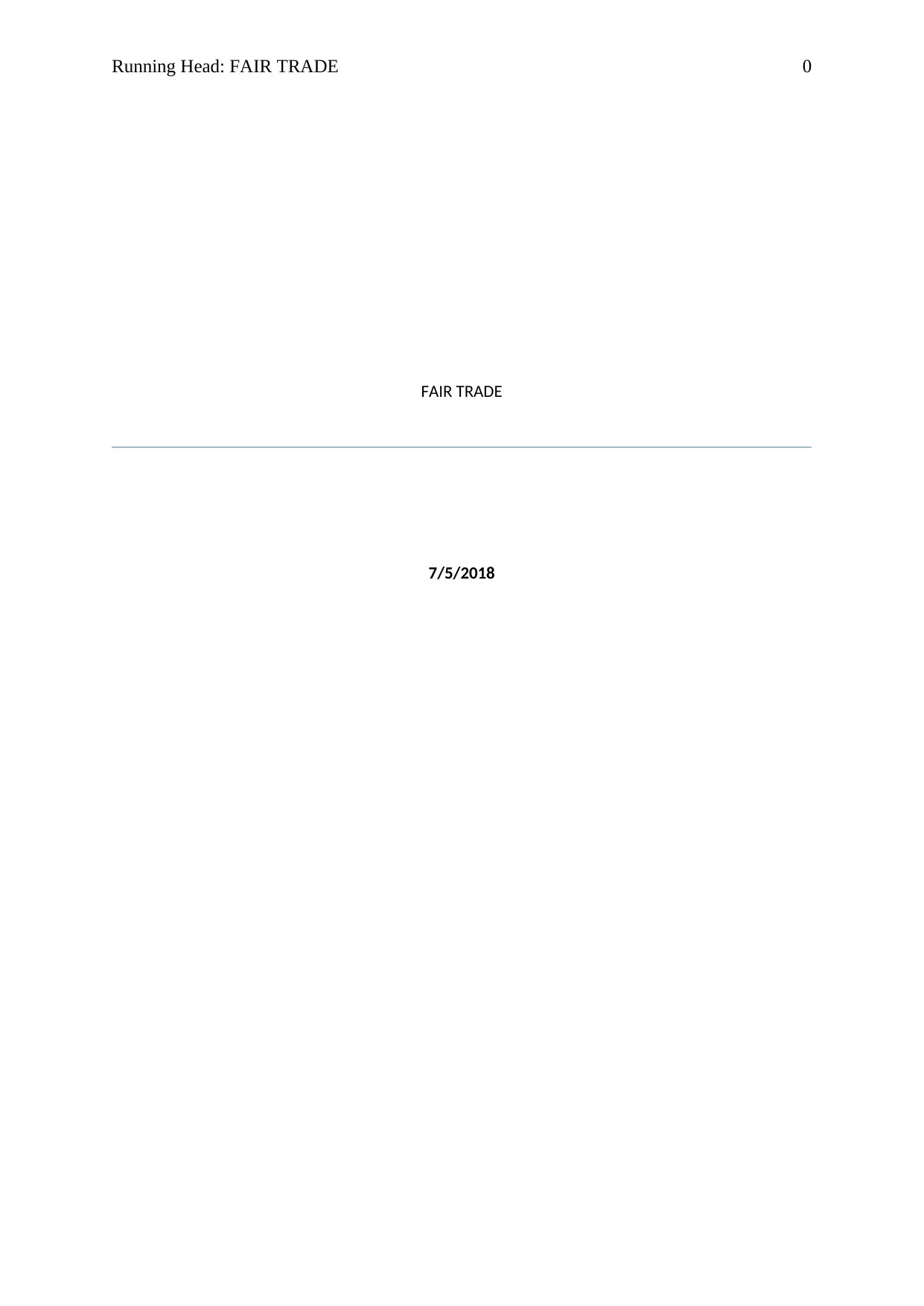
Running Head: FAIR TRADE 0
FAIR TRADE
7/5/2018
FAIR TRADE
7/5/2018
Secure Best Marks with AI Grader
Need help grading? Try our AI Grader for instant feedback on your assignments.
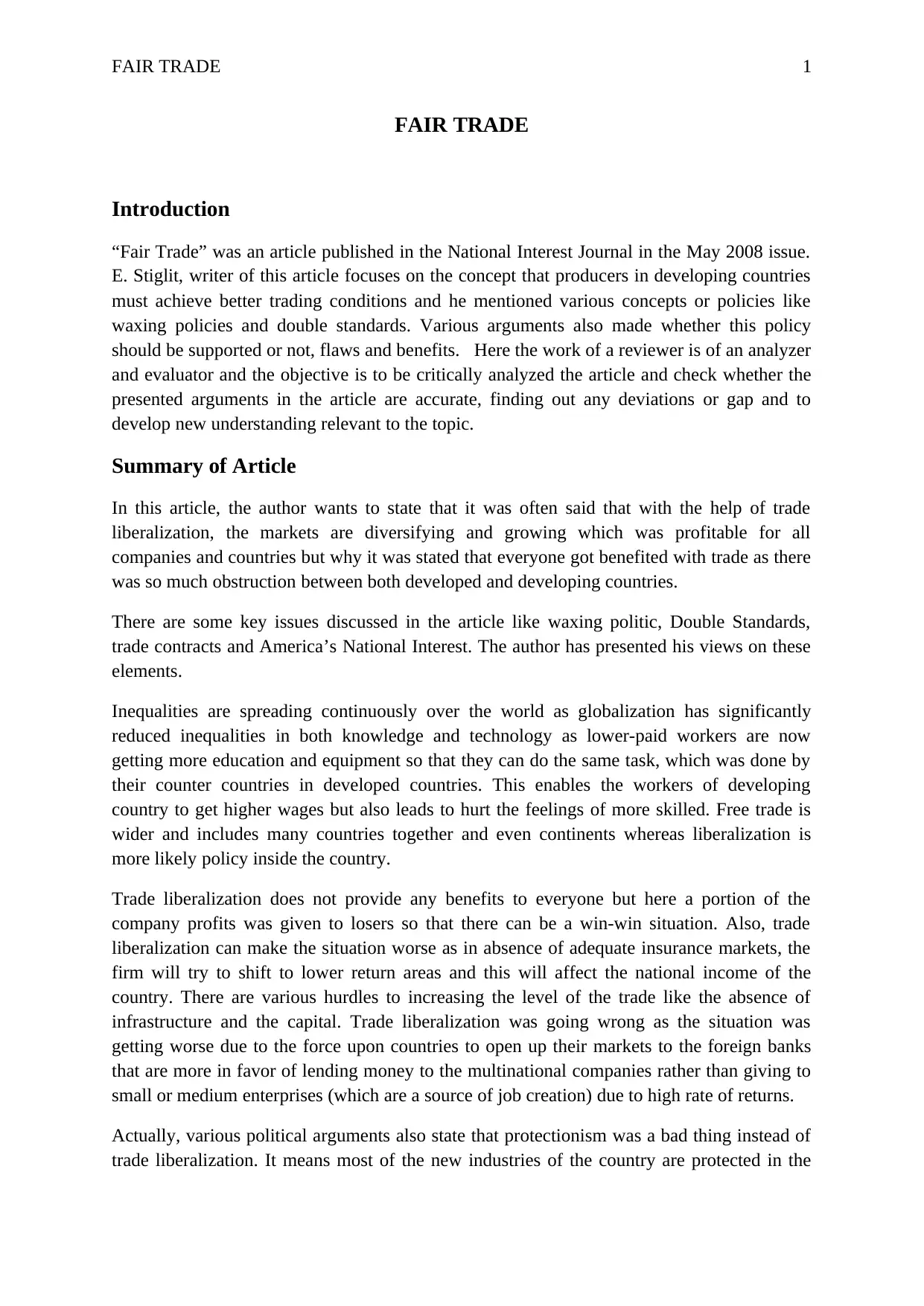
FAIR TRADE 1
FAIR TRADE
Introduction
“Fair Trade” was an article published in the National Interest Journal in the May 2008 issue.
E. Stiglit, writer of this article focuses on the concept that producers in developing countries
must achieve better trading conditions and he mentioned various concepts or policies like
waxing policies and double standards. Various arguments also made whether this policy
should be supported or not, flaws and benefits. Here the work of a reviewer is of an analyzer
and evaluator and the objective is to be critically analyzed the article and check whether the
presented arguments in the article are accurate, finding out any deviations or gap and to
develop new understanding relevant to the topic.
Summary of Article
In this article, the author wants to state that it was often said that with the help of trade
liberalization, the markets are diversifying and growing which was profitable for all
companies and countries but why it was stated that everyone got benefited with trade as there
was so much obstruction between both developed and developing countries.
There are some key issues discussed in the article like waxing politic, Double Standards,
trade contracts and America’s National Interest. The author has presented his views on these
elements.
Inequalities are spreading continuously over the world as globalization has significantly
reduced inequalities in both knowledge and technology as lower-paid workers are now
getting more education and equipment so that they can do the same task, which was done by
their counter countries in developed countries. This enables the workers of developing
country to get higher wages but also leads to hurt the feelings of more skilled. Free trade is
wider and includes many countries together and even continents whereas liberalization is
more likely policy inside the country.
Trade liberalization does not provide any benefits to everyone but here a portion of the
company profits was given to losers so that there can be a win-win situation. Also, trade
liberalization can make the situation worse as in absence of adequate insurance markets, the
firm will try to shift to lower return areas and this will affect the national income of the
country. There are various hurdles to increasing the level of the trade like the absence of
infrastructure and the capital. Trade liberalization was going wrong as the situation was
getting worse due to the force upon countries to open up their markets to the foreign banks
that are more in favor of lending money to the multinational companies rather than giving to
small or medium enterprises (which are a source of job creation) due to high rate of returns.
Actually, various political arguments also state that protectionism was a bad thing instead of
trade liberalization. It means most of the new industries of the country are protected in the
FAIR TRADE
Introduction
“Fair Trade” was an article published in the National Interest Journal in the May 2008 issue.
E. Stiglit, writer of this article focuses on the concept that producers in developing countries
must achieve better trading conditions and he mentioned various concepts or policies like
waxing policies and double standards. Various arguments also made whether this policy
should be supported or not, flaws and benefits. Here the work of a reviewer is of an analyzer
and evaluator and the objective is to be critically analyzed the article and check whether the
presented arguments in the article are accurate, finding out any deviations or gap and to
develop new understanding relevant to the topic.
Summary of Article
In this article, the author wants to state that it was often said that with the help of trade
liberalization, the markets are diversifying and growing which was profitable for all
companies and countries but why it was stated that everyone got benefited with trade as there
was so much obstruction between both developed and developing countries.
There are some key issues discussed in the article like waxing politic, Double Standards,
trade contracts and America’s National Interest. The author has presented his views on these
elements.
Inequalities are spreading continuously over the world as globalization has significantly
reduced inequalities in both knowledge and technology as lower-paid workers are now
getting more education and equipment so that they can do the same task, which was done by
their counter countries in developed countries. This enables the workers of developing
country to get higher wages but also leads to hurt the feelings of more skilled. Free trade is
wider and includes many countries together and even continents whereas liberalization is
more likely policy inside the country.
Trade liberalization does not provide any benefits to everyone but here a portion of the
company profits was given to losers so that there can be a win-win situation. Also, trade
liberalization can make the situation worse as in absence of adequate insurance markets, the
firm will try to shift to lower return areas and this will affect the national income of the
country. There are various hurdles to increasing the level of the trade like the absence of
infrastructure and the capital. Trade liberalization was going wrong as the situation was
getting worse due to the force upon countries to open up their markets to the foreign banks
that are more in favor of lending money to the multinational companies rather than giving to
small or medium enterprises (which are a source of job creation) due to high rate of returns.
Actually, various political arguments also state that protectionism was a bad thing instead of
trade liberalization. It means most of the new industries of the country are protected in the
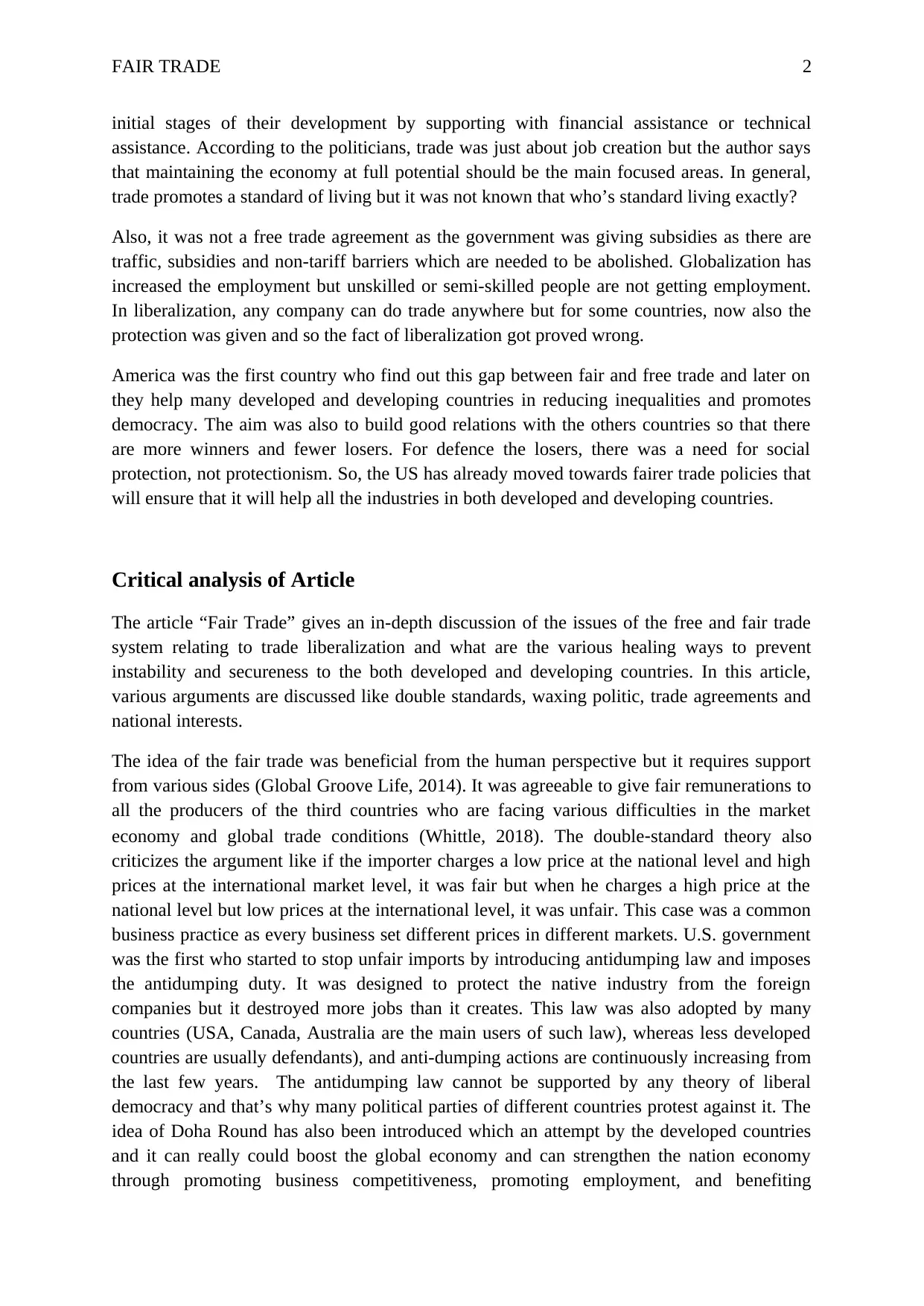
FAIR TRADE 2
initial stages of their development by supporting with financial assistance or technical
assistance. According to the politicians, trade was just about job creation but the author says
that maintaining the economy at full potential should be the main focused areas. In general,
trade promotes a standard of living but it was not known that who’s standard living exactly?
Also, it was not a free trade agreement as the government was giving subsidies as there are
traffic, subsidies and non-tariff barriers which are needed to be abolished. Globalization has
increased the employment but unskilled or semi-skilled people are not getting employment.
In liberalization, any company can do trade anywhere but for some countries, now also the
protection was given and so the fact of liberalization got proved wrong.
America was the first country who find out this gap between fair and free trade and later on
they help many developed and developing countries in reducing inequalities and promotes
democracy. The aim was also to build good relations with the others countries so that there
are more winners and fewer losers. For defence the losers, there was a need for social
protection, not protectionism. So, the US has already moved towards fairer trade policies that
will ensure that it will help all the industries in both developed and developing countries.
Critical analysis of Article
The article “Fair Trade” gives an in-depth discussion of the issues of the free and fair trade
system relating to trade liberalization and what are the various healing ways to prevent
instability and secureness to the both developed and developing countries. In this article,
various arguments are discussed like double standards, waxing politic, trade agreements and
national interests.
The idea of the fair trade was beneficial from the human perspective but it requires support
from various sides (Global Groove Life, 2014). It was agreeable to give fair remunerations to
all the producers of the third countries who are facing various difficulties in the market
economy and global trade conditions (Whittle, 2018). The double‐standard theory also
criticizes the argument like if the importer charges a low price at the national level and high
prices at the international market level, it was fair but when he charges a high price at the
national level but low prices at the international level, it was unfair. This case was a common
business practice as every business set different prices in different markets. U.S. government
was the first who started to stop unfair imports by introducing antidumping law and imposes
the antidumping duty. It was designed to protect the native industry from the foreign
companies but it destroyed more jobs than it creates. This law was also adopted by many
countries (USA, Canada, Australia are the main users of such law), whereas less developed
countries are usually defendants), and anti-dumping actions are continuously increasing from
the last few years. The antidumping law cannot be supported by any theory of liberal
democracy and that’s why many political parties of different countries protest against it. The
idea of Doha Round has also been introduced which an attempt by the developed countries
and it can really could boost the global economy and can strengthen the nation economy
through promoting business competitiveness, promoting employment, and benefiting
initial stages of their development by supporting with financial assistance or technical
assistance. According to the politicians, trade was just about job creation but the author says
that maintaining the economy at full potential should be the main focused areas. In general,
trade promotes a standard of living but it was not known that who’s standard living exactly?
Also, it was not a free trade agreement as the government was giving subsidies as there are
traffic, subsidies and non-tariff barriers which are needed to be abolished. Globalization has
increased the employment but unskilled or semi-skilled people are not getting employment.
In liberalization, any company can do trade anywhere but for some countries, now also the
protection was given and so the fact of liberalization got proved wrong.
America was the first country who find out this gap between fair and free trade and later on
they help many developed and developing countries in reducing inequalities and promotes
democracy. The aim was also to build good relations with the others countries so that there
are more winners and fewer losers. For defence the losers, there was a need for social
protection, not protectionism. So, the US has already moved towards fairer trade policies that
will ensure that it will help all the industries in both developed and developing countries.
Critical analysis of Article
The article “Fair Trade” gives an in-depth discussion of the issues of the free and fair trade
system relating to trade liberalization and what are the various healing ways to prevent
instability and secureness to the both developed and developing countries. In this article,
various arguments are discussed like double standards, waxing politic, trade agreements and
national interests.
The idea of the fair trade was beneficial from the human perspective but it requires support
from various sides (Global Groove Life, 2014). It was agreeable to give fair remunerations to
all the producers of the third countries who are facing various difficulties in the market
economy and global trade conditions (Whittle, 2018). The double‐standard theory also
criticizes the argument like if the importer charges a low price at the national level and high
prices at the international market level, it was fair but when he charges a high price at the
national level but low prices at the international level, it was unfair. This case was a common
business practice as every business set different prices in different markets. U.S. government
was the first who started to stop unfair imports by introducing antidumping law and imposes
the antidumping duty. It was designed to protect the native industry from the foreign
companies but it destroyed more jobs than it creates. This law was also adopted by many
countries (USA, Canada, Australia are the main users of such law), whereas less developed
countries are usually defendants), and anti-dumping actions are continuously increasing from
the last few years. The antidumping law cannot be supported by any theory of liberal
democracy and that’s why many political parties of different countries protest against it. The
idea of Doha Round has also been introduced which an attempt by the developed countries
and it can really could boost the global economy and can strengthen the nation economy
through promoting business competitiveness, promoting employment, and benefiting
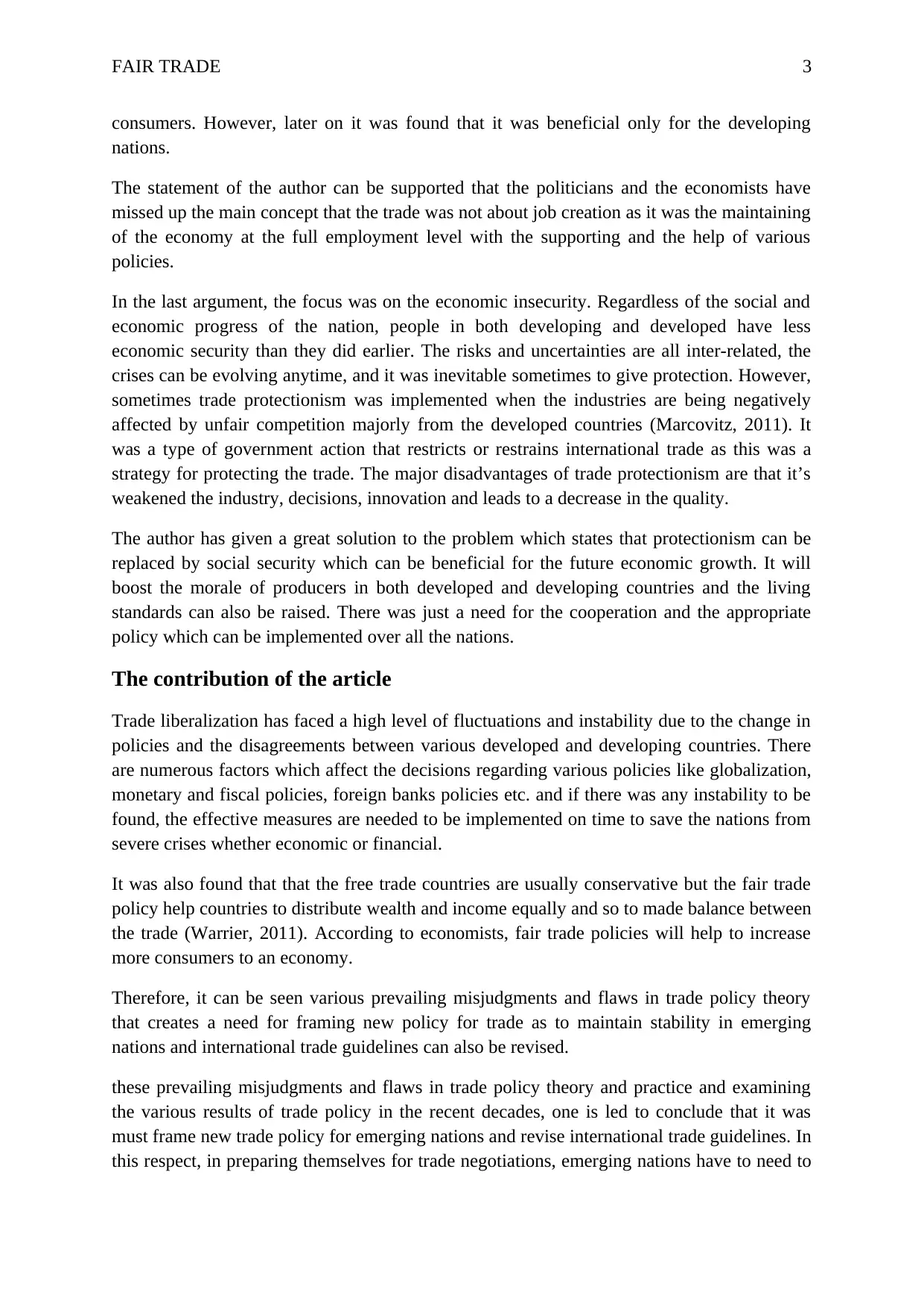
FAIR TRADE 3
consumers. However, later on it was found that it was beneficial only for the developing
nations.
The statement of the author can be supported that the politicians and the economists have
missed up the main concept that the trade was not about job creation as it was the maintaining
of the economy at the full employment level with the supporting and the help of various
policies.
In the last argument, the focus was on the economic insecurity. Regardless of the social and
economic progress of the nation, people in both developing and developed have less
economic security than they did earlier. The risks and uncertainties are all inter-related, the
crises can be evolving anytime, and it was inevitable sometimes to give protection. However,
sometimes trade protectionism was implemented when the industries are being negatively
affected by unfair competition majorly from the developed countries (Marcovitz, 2011). It
was a type of government action that restricts or restrains international trade as this was a
strategy for protecting the trade. The major disadvantages of trade protectionism are that it’s
weakened the industry, decisions, innovation and leads to a decrease in the quality.
The author has given a great solution to the problem which states that protectionism can be
replaced by social security which can be beneficial for the future economic growth. It will
boost the morale of producers in both developed and developing countries and the living
standards can also be raised. There was just a need for the cooperation and the appropriate
policy which can be implemented over all the nations.
The contribution of the article
Trade liberalization has faced a high level of fluctuations and instability due to the change in
policies and the disagreements between various developed and developing countries. There
are numerous factors which affect the decisions regarding various policies like globalization,
monetary and fiscal policies, foreign banks policies etc. and if there was any instability to be
found, the effective measures are needed to be implemented on time to save the nations from
severe crises whether economic or financial.
It was also found that that the free trade countries are usually conservative but the fair trade
policy help countries to distribute wealth and income equally and so to made balance between
the trade (Warrier, 2011). According to economists, fair trade policies will help to increase
more consumers to an economy.
Therefore, it can be seen various prevailing misjudgments and flaws in trade policy theory
that creates a need for framing new policy for trade as to maintain stability in emerging
nations and international trade guidelines can also be revised.
these prevailing misjudgments and flaws in trade policy theory and practice and examining
the various results of trade policy in the recent decades, one is led to conclude that it was
must frame new trade policy for emerging nations and revise international trade guidelines. In
this respect, in preparing themselves for trade negotiations, emerging nations have to need to
consumers. However, later on it was found that it was beneficial only for the developing
nations.
The statement of the author can be supported that the politicians and the economists have
missed up the main concept that the trade was not about job creation as it was the maintaining
of the economy at the full employment level with the supporting and the help of various
policies.
In the last argument, the focus was on the economic insecurity. Regardless of the social and
economic progress of the nation, people in both developing and developed have less
economic security than they did earlier. The risks and uncertainties are all inter-related, the
crises can be evolving anytime, and it was inevitable sometimes to give protection. However,
sometimes trade protectionism was implemented when the industries are being negatively
affected by unfair competition majorly from the developed countries (Marcovitz, 2011). It
was a type of government action that restricts or restrains international trade as this was a
strategy for protecting the trade. The major disadvantages of trade protectionism are that it’s
weakened the industry, decisions, innovation and leads to a decrease in the quality.
The author has given a great solution to the problem which states that protectionism can be
replaced by social security which can be beneficial for the future economic growth. It will
boost the morale of producers in both developed and developing countries and the living
standards can also be raised. There was just a need for the cooperation and the appropriate
policy which can be implemented over all the nations.
The contribution of the article
Trade liberalization has faced a high level of fluctuations and instability due to the change in
policies and the disagreements between various developed and developing countries. There
are numerous factors which affect the decisions regarding various policies like globalization,
monetary and fiscal policies, foreign banks policies etc. and if there was any instability to be
found, the effective measures are needed to be implemented on time to save the nations from
severe crises whether economic or financial.
It was also found that that the free trade countries are usually conservative but the fair trade
policy help countries to distribute wealth and income equally and so to made balance between
the trade (Warrier, 2011). According to economists, fair trade policies will help to increase
more consumers to an economy.
Therefore, it can be seen various prevailing misjudgments and flaws in trade policy theory
that creates a need for framing new policy for trade as to maintain stability in emerging
nations and international trade guidelines can also be revised.
these prevailing misjudgments and flaws in trade policy theory and practice and examining
the various results of trade policy in the recent decades, one is led to conclude that it was
must frame new trade policy for emerging nations and revise international trade guidelines. In
this respect, in preparing themselves for trade negotiations, emerging nations have to need to
Secure Best Marks with AI Grader
Need help grading? Try our AI Grader for instant feedback on your assignments.
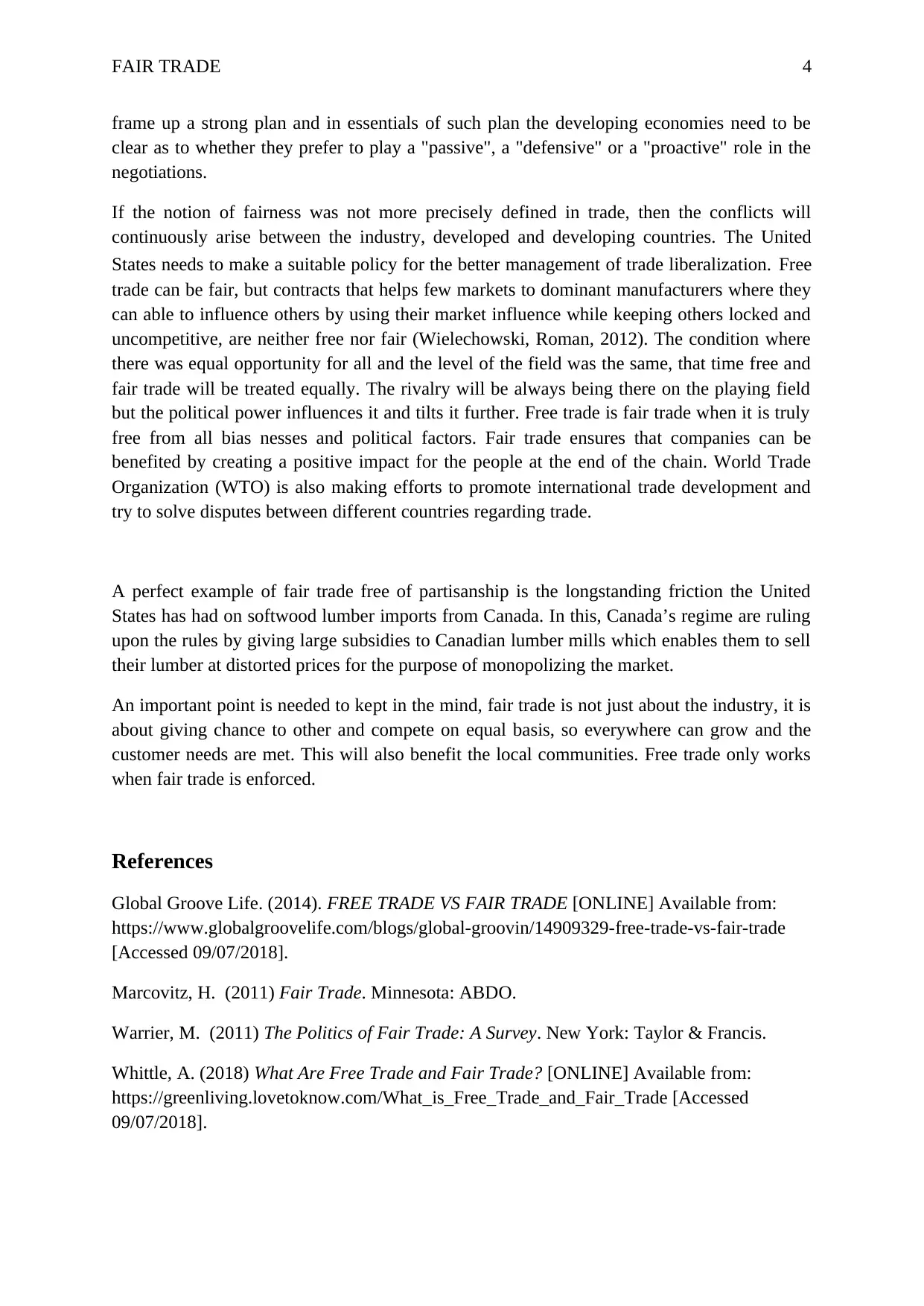
FAIR TRADE 4
frame up a strong plan and in essentials of such plan the developing economies need to be
clear as to whether they prefer to play a "passive", a "defensive" or a "proactive" role in the
negotiations.
If the notion of fairness was not more precisely defined in trade, then the conflicts will
continuously arise between the industry, developed and developing countries. The United
States needs to make a suitable policy for the better management of trade liberalization. Free
trade can be fair, but contracts that helps few markets to dominant manufacturers where they
can able to influence others by using their market influence while keeping others locked and
uncompetitive, are neither free nor fair (Wielechowski, Roman, 2012). The condition where
there was equal opportunity for all and the level of the field was the same, that time free and
fair trade will be treated equally. The rivalry will be always being there on the playing field
but the political power influences it and tilts it further. Free trade is fair trade when it is truly
free from all bias nesses and political factors. Fair trade ensures that companies can be
benefited by creating a positive impact for the people at the end of the chain. World Trade
Organization (WTO) is also making efforts to promote international trade development and
try to solve disputes between different countries regarding trade.
A perfect example of fair trade free of partisanship is the longstanding friction the United
States has had on softwood lumber imports from Canada. In this, Canada’s regime are ruling
upon the rules by giving large subsidies to Canadian lumber mills which enables them to sell
their lumber at distorted prices for the purpose of monopolizing the market.
An important point is needed to kept in the mind, fair trade is not just about the industry, it is
about giving chance to other and compete on equal basis, so everywhere can grow and the
customer needs are met. This will also benefit the local communities. Free trade only works
when fair trade is enforced.
References
Global Groove Life. (2014). FREE TRADE VS FAIR TRADE [ONLINE] Available from:
https://www.globalgroovelife.com/blogs/global-groovin/14909329-free-trade-vs-fair-trade
[Accessed 09/07/2018].
Marcovitz, H. (2011) Fair Trade. Minnesota: ABDO.
Warrier, M. (2011) The Politics of Fair Trade: A Survey. New York: Taylor & Francis.
Whittle, A. (2018) What Are Free Trade and Fair Trade? [ONLINE] Available from:
https://greenliving.lovetoknow.com/What_is_Free_Trade_and_Fair_Trade [Accessed
09/07/2018].
frame up a strong plan and in essentials of such plan the developing economies need to be
clear as to whether they prefer to play a "passive", a "defensive" or a "proactive" role in the
negotiations.
If the notion of fairness was not more precisely defined in trade, then the conflicts will
continuously arise between the industry, developed and developing countries. The United
States needs to make a suitable policy for the better management of trade liberalization. Free
trade can be fair, but contracts that helps few markets to dominant manufacturers where they
can able to influence others by using their market influence while keeping others locked and
uncompetitive, are neither free nor fair (Wielechowski, Roman, 2012). The condition where
there was equal opportunity for all and the level of the field was the same, that time free and
fair trade will be treated equally. The rivalry will be always being there on the playing field
but the political power influences it and tilts it further. Free trade is fair trade when it is truly
free from all bias nesses and political factors. Fair trade ensures that companies can be
benefited by creating a positive impact for the people at the end of the chain. World Trade
Organization (WTO) is also making efforts to promote international trade development and
try to solve disputes between different countries regarding trade.
A perfect example of fair trade free of partisanship is the longstanding friction the United
States has had on softwood lumber imports from Canada. In this, Canada’s regime are ruling
upon the rules by giving large subsidies to Canadian lumber mills which enables them to sell
their lumber at distorted prices for the purpose of monopolizing the market.
An important point is needed to kept in the mind, fair trade is not just about the industry, it is
about giving chance to other and compete on equal basis, so everywhere can grow and the
customer needs are met. This will also benefit the local communities. Free trade only works
when fair trade is enforced.
References
Global Groove Life. (2014). FREE TRADE VS FAIR TRADE [ONLINE] Available from:
https://www.globalgroovelife.com/blogs/global-groovin/14909329-free-trade-vs-fair-trade
[Accessed 09/07/2018].
Marcovitz, H. (2011) Fair Trade. Minnesota: ABDO.
Warrier, M. (2011) The Politics of Fair Trade: A Survey. New York: Taylor & Francis.
Whittle, A. (2018) What Are Free Trade and Fair Trade? [ONLINE] Available from:
https://greenliving.lovetoknow.com/What_is_Free_Trade_and_Fair_Trade [Accessed
09/07/2018].
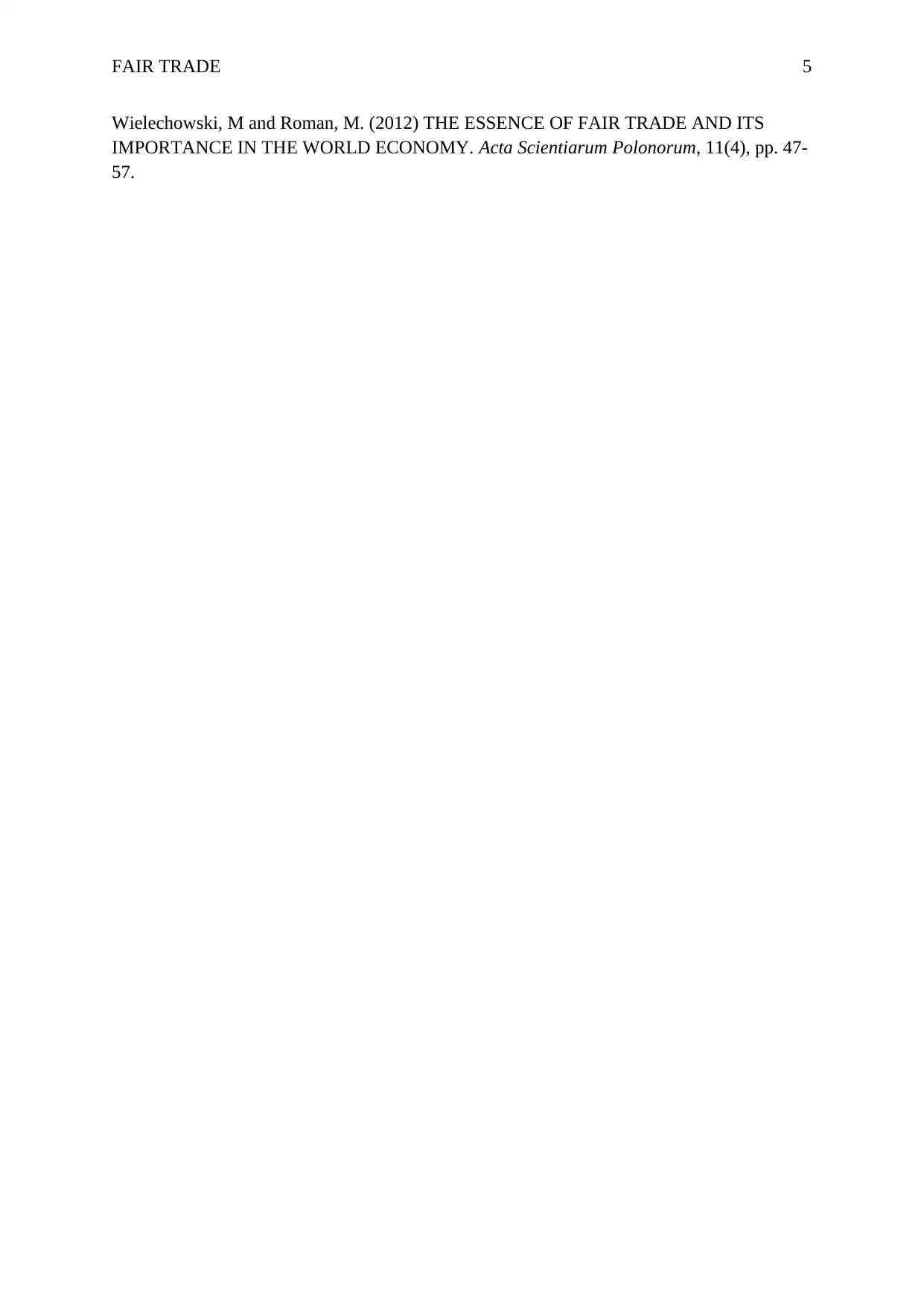
FAIR TRADE 5
Wielechowski, M and Roman, M. (2012) THE ESSENCE OF FAIR TRADE AND ITS
IMPORTANCE IN THE WORLD ECONOMY. Acta Scientiarum Polonorum, 11(4), pp. 47-
57.
Wielechowski, M and Roman, M. (2012) THE ESSENCE OF FAIR TRADE AND ITS
IMPORTANCE IN THE WORLD ECONOMY. Acta Scientiarum Polonorum, 11(4), pp. 47-
57.
1 out of 6
Related Documents
Your All-in-One AI-Powered Toolkit for Academic Success.
+13062052269
info@desklib.com
Available 24*7 on WhatsApp / Email
![[object Object]](/_next/static/media/star-bottom.7253800d.svg)
Unlock your academic potential
© 2024 | Zucol Services PVT LTD | All rights reserved.





